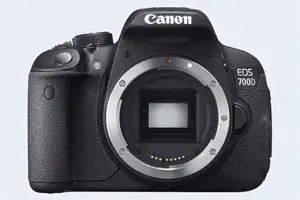Canon 700D vs Sony RX1R II
The Canon EOS 700D (called Canon T5i in some regions) and the Sony Cyber-shot DSC-RX1R II are two digital cameras that were announced, respectively, in March 2013 and October 2015. The 700D is a DSLR, while the RX1R II is a fixed lens compact. The cameras are based on an APS-C (700D) and a full frame (RX1R II) sensor. The Canon has a resolution of 17.9 megapixels, whereas the Sony provides 42.2 MP.
Below is an overview of the main specs of the two cameras as a starting point for the comparison.

Check 700D offers at
ebay.com

Check RX1R II offers at
ebay.com
Going beyond this snapshot of core features and characteristics, what are the differences between the Canon EOS 700D and the Sony Cyber-shot DSC-RX1R II? Which one should you buy? Read on to find out how these two cameras compare with respect to their body size, their imaging sensors, their shooting features, their input-output connections, and their reception by expert reviewers.
Body comparison
The side-by-side display below illustrates the physical size and weight of the Canon 700D and the Sony RX1R II. The two cameras are presented according to their relative size. Three successive views from the front, the top, and the rear are shown. All width, height and depth measures are rounded to the nearest millimeter.
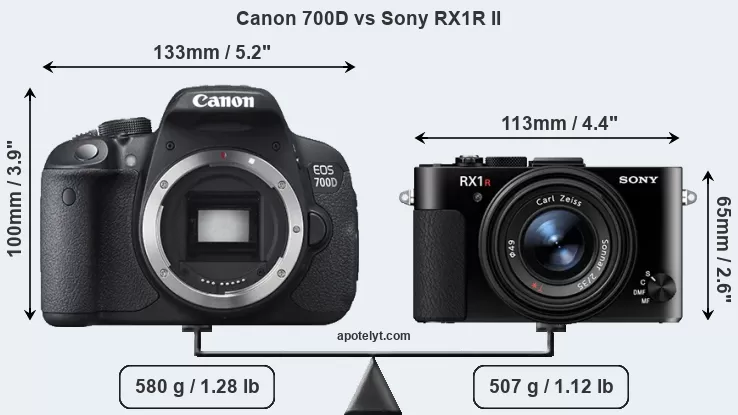
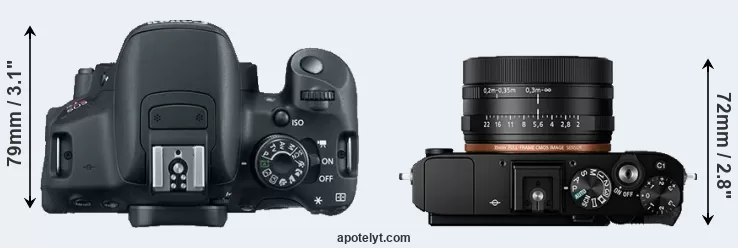
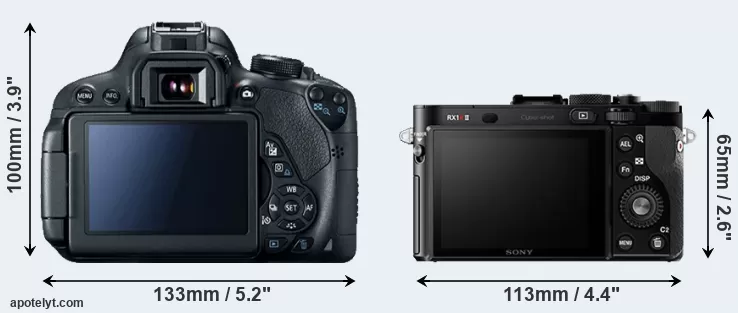
If the front view area (width x height) of the cameras is taken as an aggregate measure of their size, the Sony RX1R II is considerably smaller (45 percent) than the Canon 700D. In this context, it is worth noting that neither the 700D nor the RX1R II are weather-sealed.
The above size and weight comparisons are to some extent incomplete and possibly misleading, as the RX1R II has a lens built in, whereas the 700D is an interchangeable lens camera that requires a separate lens. Attaching the latter will add extra weight and bulk to the setup. You can compare the optics available for the 700D and their specifications in the Canon EF Lens Catalog.
Concerning battery life, the 700D gets 440 shots out of its Canon LP-E8 battery, while the RX1R II can take 220 images on a single charge of its Sony NP-BX1 power pack. The power pack in the RX1R II can be charged via the USB port, which can be very convenient when travelling.
The following table provides a synthesis of the main physical specifications of the two cameras and other similar ones. In case you want to display and compare another camera duo, you can use the CAM-parator app to select your camera combination among a large number of options.

| Camera Model |
Camera Width |
Camera Height |
Camera Depth |
Camera Weight |
Battery Life |
Weather Sealing |
Camera Launch |
Launch Price (USD) |
Street Price |
||
|---|---|---|---|---|---|---|---|---|---|---|---|
| 1. | Canon 700D | 133 mm | 100 mm | 79 mm | 580 g | 440 | n | Mar 2013 | 649 | ebay.com | |
| 2. | Sony RX1R II | 113 mm | 65 mm | 72 mm | 507 g | 220 | n | Oct 2015 | 3,299 | ebay.com | |
| 3. | Canon 5DS | 152 mm | 116 mm | 76 mm | 930 g | 700 | Y | Feb 2015 | 3,699 | ebay.com | |
| 4. | Canon 5DS R | 152 mm | 116 mm | 76 mm | 930 g | 700 | Y | Feb 2015 | 3,699 | ebay.com | |
| 5. | Canon 100D | 117 mm | 91 mm | 69 mm | 407 g | 380 | n | Mar 2013 | 549 | ebay.com | |
| 6. | Canon 500D | 129 mm | 98 mm | 62 mm | 520 g | 400 | n | Mar 2009 | 799 | ebay.com | |
| 7. | Canon 550D | 129 mm | 98 mm | 62 mm | 530 g | 440 | n | Feb 2010 | 699 | ebay.com | |
| 8. | Canon 600D | 133 mm | 100 mm | 80 mm | 570 g | 440 | n | Feb 2011 | 599 | ebay.com | |
| 9. | Canon 650D | 133 mm | 100 mm | 79 mm | 575 g | 440 | n | Jun 2012 | 849 | ebay.com | |
| 10. | Canon 750D | 132 mm | 101 mm | 78 mm | 555 g | 440 | n | Feb 2015 | 749 | ebay.com | |
| 11. | Canon 760D | 132 mm | 101 mm | 78 mm | 565 g | 440 | n | Feb 2015 | 649 | ebay.com | |
| 12. | Canon 1200D | 130 mm | 100 mm | 78 mm | 480 g | 500 | n | Feb 2014 | 449 | ebay.com | |
| 13. | Canon G7 X | 103 mm | 60 mm | 40 mm | 304 g | 210 | n | Sep 2014 | 699 | ebay.com | |
| 14. | Canon M | 109 mm | 66 mm | 32 mm | 298 g | 230 | n | Jul 2012 | 599 | ebay.com | |
| 15. | Leica Q Typ 116 | 130 mm | 80 mm | 93 mm | 640 g | 300 | n | Jun 2015 | 4,249 | ebay.com | |
| 16. | Sony RX1 | 113 mm | 65 mm | 70 mm | 482 g | 270 | n | Sep 2012 | 2,799 | ebay.com | |
| 17. | Sony RX1R | 113 mm | 65 mm | 70 mm | 482 g | 270 | n | Jun 2013 | 2,799 | ebay.com | |
| Note: Measurements and pricing do not include easily detachable parts, such as add-on or interchangeable lenses or optional viewfinders. | |||||||||||
Any camera decision will obviously take relative prices into account. The listed launch prices provide an indication of the market segment that the manufacturer of the cameras have been targeting. Normally, street prices remain initially close to the MSRP, but after a couple of months, the first discounts appear. Later in the product cycle and, in particular, when the replacement model is about to appear, further discounting and stock clearance sales often push the camera price considerably down.
Sensor comparison
The size of the imaging sensor is a crucial determinant of image quality. All other things equal, a large sensor will have larger individual pixel-units that offer better low-light sensitivity, wider dynamic range, and richer color-depth than smaller pixels in a sensor of the same technological generation. Moreover, a large sensor camera will give the photographer more control over depth-of-field in the image and, thus, the ability to better isolate a subject from the background. On the downside, larger sensors are more costly to manufacture and tend to lead to bigger and heavier cameras and lenses.
Of the two cameras under consideration, the Canon 700D features an APS-C sensor and the Sony RX1R II a full frame sensor. The sensor area in the RX1R II is 158 percent bigger. As a result of these sensor size differences, the cameras have a format factor of, respectively, 1.6 and 1.0. Both cameras have a native aspect ratio (sensor width to sensor height) of 3:2.
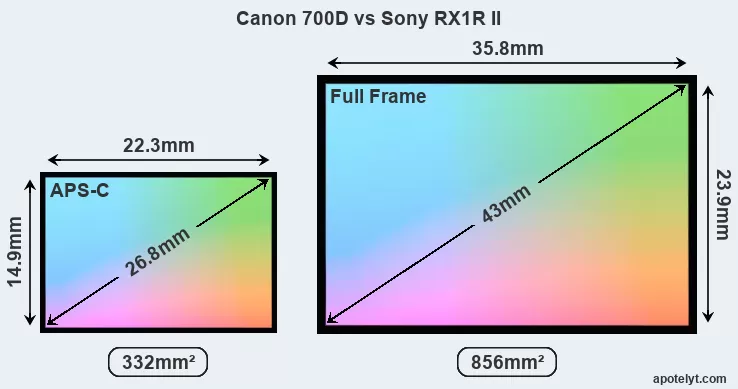
With 42.2MP, the RX1R II offers a higher resolution than the 700D (17.9MP), but the RX1R II nevertheless has larger individual pixels (pixel pitch of 4.50μm versus 4.31μm for the 700D) due to its larger sensor. Moreover, the RX1R II is a much more recent model (by 2 years and 6 months) than the 700D, and its sensor will have benefitted from technological advances during this time that further enhance the light gathering capacity of its pixel-units. Coming back to sensor resolution, it should be mentioned that the RX1R II has no anti-alias filter installed, so that it can capture all the detail its sensor resolves.
The resolution advantage of the Sony RX1R II implies greater flexibility for cropping images or the possibility to print larger pictures. The maximum print size of the RX1R II for good quality output (200 dots per inch) amounts to 39.8 x 26.5 inches or 101 x 67.4 cm, for very good quality (250 dpi) 31.8 x 21.2 inches or 80.8 x 53.9 cm, and for excellent quality (300 dpi) 26.5 x 17.7 inches or 67.3 x 44.9 cm. The corresponding values for the Canon 700D are 25.9 x 17.3 inches or 65.8 x 43.9 cm for good quality, 20.7 x 13.8 inches or 52.7 x 35.1 cm for very good quality, and 17.3 x 11.5 inches or 43.9 x 29.3 cm for excellent quality prints.
The 700D has on-sensor phase detect pixels, which results in fast and reliable autofocus acquisition even during live view operation.
The Canon EOS 700D has a native sensitivity range from ISO 100 to ISO 12800, which can be extended to ISO 100-25600. The corresponding ISO settings for the Sony Cyber-shot DSC-RX1R II are ISO 100 to ISO 25600, with the possibility to increase the ISO range to 50-102400.
In terms of underlying technology, the 700D is build around a CMOS sensor, while the RX1R II uses a BSI-CMOS imager. Both cameras use a Bayer filter for capturing RGB colors on a square grid of photosensors. This arrangement is found in most digital cameras.
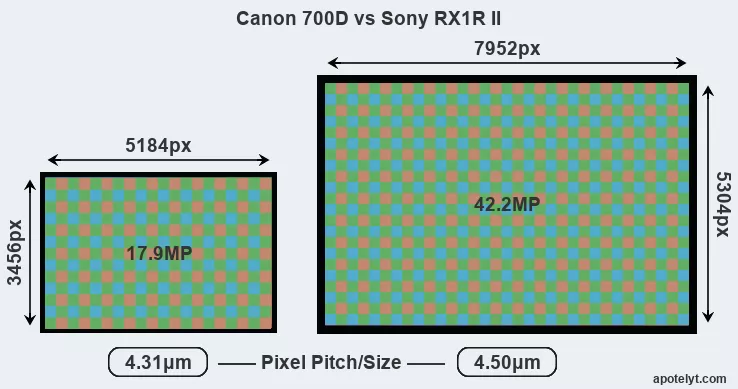
Since 2007, DXO Mark has published sensor performance measurements that have been derived using a consistent methodology. This service is based on lab testing and assigns an overall score to each camera sensor, as well as ratings for dynamic range ("DXO Landscape"), color depth ("DXO Portrait"), and low-light sensitivity ("DXO Sports"). Of the two cameras under consideration, the RX1R II offers substantially better image quality than the 700D (overall score 36 points higher). The advantage is based on 4.1 bits higher color depth, 2.7 EV in additional dynamic range, and 2.2 stops in additional low light sensitivity. The following table provides an overview of the physical sensor characteristics, as well as the sensor quality measurements for a selection of comparators.

| Camera Model |
Sensor Class |
Resolution (MP) |
Horiz. Pixels |
Vert. Pixels |
Video Format |
DXO Portrait |
DXO Landscape |
DXO Sports |
DXO Overall |
||
|---|---|---|---|---|---|---|---|---|---|---|---|
| 1. | Canon 700D | APS-C | 17.9 | 5184 | 3456 | 1080/30p | 21.7 | 11.2 | 681 | 61 | |
| 2. | Sony RX1R II | Full Frame | 42.2 | 7952 | 5304 | 1080/60p | 25.8 | 13.9 | 3204 | 97 | |
| 3. | Canon 5DS | Full Frame | 50.3 | 8688 | 5792 | 1080/30p | 24.7 | 12.4 | 2381 | 87 | |
| 4. | Canon 5DS R | Full Frame | 50.3 | 8688 | 5792 | 1080/30p | 24.6 | 12.4 | 2308 | 86 | |
| 5. | Canon 100D | APS-C | 17.9 | 5184 | 3456 | 1080/30p | 21.8 | 11.3 | 843 | 63 | |
| 6. | Canon 500D | APS-C | 15.1 | 4752 | 3168 | 1080/20p | 21.7 | 11.5 | 663 | 63 | |
| 7. | Canon 550D | APS-C | 17.9 | 5184 | 3456 | 1080/30p | 22.1 | 11.5 | 784 | 66 | |
| 8. | Canon 600D | APS-C | 17.9 | 5184 | 3456 | 1080/30p | 22.1 | 11.5 | 793 | 65 | |
| 9. | Canon 650D | APS-C | 17.9 | 5184 | 3456 | 1080/30p | 21.7 | 11.2 | 722 | 62 | |
| 10. | Canon 750D | APS-C | 24.0 | 6000 | 4000 | 1080/30p | 22.7 | 12.0 | 919 | 71 | |
| 11. | Canon 760D | APS-C | 24.0 | 6000 | 4000 | 1080/30p | 22.6 | 12.0 | 915 | 70 | |
| 12. | Canon 1200D | APS-C | 17.9 | 5184 | 3456 | 1080/30p | 21.9 | 11.3 | 724 | 63 | |
| 13. | Canon G7 X | 1-inch | 20.0 | 5472 | 3648 | 1080/60p | 23.0 | 12.7 | 556 | 71 | |
| 14. | Canon M | APS-C | 17.9 | 5184 | 3456 | 1080/30p | 22.1 | 11.2 | 827 | 65 | |
| 15. | Leica Q Typ 116 | Full Frame | 24.0 | 6000 | 4000 | 1080/60p | 24.3 | 12.7 | 2221 | 85 | |
| 16. | Sony RX1 | Full Frame | 24.0 | 6000 | 4000 | 1080/60p | 25.1 | 14.3 | 2534 | 93 | |
| 17. | Sony RX1R | Full Frame | 24.0 | 6000 | 4000 | 1080/60p | 25.0 | 13.6 | 2537 | 91 |
Many modern cameras are not only capable of taking still images, but can also record movies. Both cameras under consideration have a sensor with sufficiently fast read-out times for moving pictures, but the RX1R II provides a faster frame rate than the 700D. It can shoot movie footage at 1080/60p, while the Canon is limited to 1080/30p.
Feature comparison
Apart from body and sensor, cameras can and do differ across a range of features. For example, the RX1R II has an electronic viewfinder (2360k dots), while the 700D has an optical one. Both systems have their advantages, with the electronic viewfinder making it possible to project supplementary shooting information into the framing view, whereas the optical viewfinder offers lag-free viewing and a very clear framing image. The viewfinder in the RX1R II offers a wider field of view (100%) than the one in the 700D (95%), so that a larger proportion of the captured image is visible in the finder. In addition, the viewfinder of the RX1R II has a higher magnification (0.74x vs 0.53x), so that the size of the image transmitted appears closer to the size seen with the naked human eye. The table below summarizes some of the other core capabilities of the Canon 700D and Sony RX1R II in connection with corresponding information for a sample of similar cameras.

| Camera Model |
Viewfinder (Type or 000 dots) |
Control Panel (yes/no) |
LCD Specifications (inch/000 dots) |
LCD Attach- ment |
Touch Screen (yes/no) |
Max Shutter Speed * |
Max Shutter Flaps * |
Built-in Flash (yes/no) |
Built-in Image Stab |
||
|---|---|---|---|---|---|---|---|---|---|---|---|
| 1. | Canon 700D | optical | n | 3.0 / 1040 | swivel | Y | 1/4000s | 5.0/s | Y | n | |
| 2. | Sony RX1R II | 2360 | n | 3.0 / 1229 | tilting | n | 1/4000s | 5.0/s | n | n | |
| 3. | Canon 5DS | optical | Y | 3.2 / 1040 | fixed | n | 1/8000s | 5.0/s | n | n | |
| 4. | Canon 5DS R | optical | Y | 3.2 / 1040 | fixed | n | 1/8000s | 5.0/s | n | n | |
| 5. | Canon 100D | optical | n | 3.0 / 1040 | fixed | Y | 1/4000s | 4.9/s | Y | n | |
| 6. | Canon 500D | optical | n | 3.0 / 920 | fixed | n | 1/4000s | 3.4/s | Y | n | |
| 7. | Canon 550D | optical | n | 3.0 / 1040 | fixed | n | 1/4000s | 3.7/s | Y | n | |
| 8. | Canon 600D | optical | n | 3.0 / 1040 | swivel | n | 1/4000s | 3.7/s | Y | n | |
| 9. | Canon 650D | optical | n | 3.0 / 1040 | swivel | Y | 1/4000s | 5.0/s | Y | n | |
| 10. | Canon 750D | optical | n | 3.0 / 1040 | swivel | Y | 1/4000s | 5.0/s | Y | n | |
| 11. | Canon 760D | optical | Y | 3.0 / 1040 | swivel | Y | 1/4000s | 5.0/s | Y | n | |
| 12. | Canon 1200D | optical | n | 3.0 / 460 | fixed | n | 1/4000s | 3.0/s | Y | n | |
| 13. | Canon G7 X | none | n | 3.0 / 1040 | tilting | Y | 1/2000s | 6.5/s | Y | Y | |
| 14. | Canon M | none | n | 3.0 / 1040 | fixed | Y | 1/4000s | 4.3/s | n | n | |
| 15. | Leica Q Typ 116 | 3680 | n | 3.0 / 1040 | fixed | Y | 1/2000s | 10.0/s | n | Y | |
| 16. | Sony RX1 | optional | n | 3.0 / 1229 | fixed | n | 1/4000s | 5.0/s | Y | n | |
| 17. | Sony RX1R | optional | n | 3.0 / 1229 | fixed | n | 1/4000s | 5.0/s | Y | n | |
| Note: *) Information refers to the mechanical shutter, unless the camera only has an electronic one. | |||||||||||
One difference between the cameras concerns the presence of an on-board flash. The 700D has one, while the RX1R II does not. While the built-in flash of the 700D is not very powerful, it can at times be useful as a fill-in light.
The 700D has an articulated LCD that can be turned to be front-facing. This characteristic will be appreciated by vloggers and photographers who are interested in snapping selfies. In contrast, the RX1R II does not have a selfie-screen.The 700D writes its imaging data to SDXC cards, while the RX1R II uses SDXC or Memory Stick PRO Duo cards. Both cameras can use UHS-I cards, which provide for Ultra High Speed data transfer of up to 104 MB/s.
Connectivity comparison
For some imaging applications, the extent to which a camera can communicate with its environment can be an important aspect in the camera decision process. The table below provides an overview of the connectivity of the Canon EOS 700D and Sony Cyber-shot DSC-RX1R II and, in particular, the interfaces the cameras (and selected comparators) provide for accessory control and data transfer.

| Camera Model |
Hotshoe Port |
Internal Mic / Speaker |
Microphone Port |
Headphone Port |
HDMI Port |
USB Port |
WiFi Support |
NFC Support |
Bluetooth Support |
||
|---|---|---|---|---|---|---|---|---|---|---|---|
| 1. | Canon 700D | Y | stereo / mono | Y | - | mini | 2.0 | - | - | - | |
| 2. | Sony RX1R II | Y | stereo / mono | Y | - | micro | 2.0 | Y | Y | - | |
| 3. | Canon 5DS | Y | mono / mono | Y | - | mini | 3.0 | - | - | - | |
| 4. | Canon 5DS R | Y | mono / mono | Y | - | mini | 3.0 | - | - | - | |
| 5. | Canon 100D | Y | mono / mono | Y | - | mini | 2.0 | - | - | - | |
| 6. | Canon 500D | Y | mono / mono | - | - | mini | 2.0 | - | - | - | |
| 7. | Canon 550D | Y | stereo / - | Y | - | mini | 2.0 | - | - | - | |
| 8. | Canon 600D | Y | mono / mono | Y | - | mini | 2.0 | - | - | - | |
| 9. | Canon 650D | Y | stereo / mono | Y | - | mini | 2.0 | - | - | - | |
| 10. | Canon 750D | Y | stereo / mono | Y | - | mini | 2.0 | Y | Y | - | |
| 11. | Canon 760D | Y | stereo / mono | Y | - | mini | 2.0 | Y | Y | - | |
| 12. | Canon 1200D | Y | mono / mono | - | - | mini | 2.0 | - | - | - | |
| 13. | Canon G7 X | - | stereo / mono | - | - | micro | 2.0 | Y | Y | - | |
| 14. | Canon M | Y | stereo / mono | Y | - | mini | 2.0 | - | - | - | |
| 15. | Leica Q Typ 116 | Y | stereo / mono | - | - | micro | 2.0 | Y | Y | - | |
| 16. | Sony RX1 | Y | stereo / mono | Y | - | mini | 2.0 | - | - | - | |
| 17. | Sony RX1R | Y | stereo / mono | Y | - | mini | 2.0 | - | - | - |
It is notable that the RX1R II offers wifi support, which can be a very convenient means to transfer image data to an off-camera location. In contrast, the 700D does not provide wifi capability.
Both the 700D and the RX1R II have been discontinued, but can regularly be found used on ebay. The 700D was replaced by the Canon 750D, while the RX1R II does not have a direct successor. Further information on the features and operation of the 700D and RX1R II can be found, respectively, in the Canon 700D Manual (free pdf) or the online Sony RX1R II Manual.
Review summary
So what is the bottom line? Is there a clear favorite between the Canon 700D and the Sony RX1R II? Which camera is better? A synthesis of the relative strong points of each of the models is listed below.

Advantages of the Canon EOS 700D:
- Better moiré control: Has an anti-alias filter to avoid artificial patterns to appear in images.
- Better live-view autofocus: Features on-sensor phase-detection for more confident autofocus.
- Brighter framing: Features an optical viewfinder for clear, lag-free composition.
- More flexible LCD: Has a swivel screen for odd-angle shots in portrait or landscape orientation.
- Fewer buttons to press: Is equipped with a touch-sensitive rear screen to facilitate handling.
- More selfie-friendly: Has an articulated screen that can be turned to be front-facing.
- More flexible: Can take a variety of interchangeable lenses, including specialty optics.
- Longer lasting: Can take more shots (440 versus 220) on a single battery charge.
- Easier fill-in: Is equipped with a small onboard flash to brighten deep shadow areas.
- More heavily discounted: Has been available for much longer (launched in March 2013).

Reasons to prefer the Sony Cyber-shot DSC-RX1R II:
- More detail: Has more megapixels (42.2 vs 17.9MP), which boosts linear resolution by 53%.
- Maximized detail: Lacks an anti-alias filter to exploit the sensor's full resolution potential.
- Better image quality: Scores substantially higher (36 points) in the DXO overall evaluation.
- Richer colors: Generates noticeably more natural colors (4.1 bits more color depth).
- More dynamic range: Captures a broader range of light and dark details (2.7 EV of extra DR).
- Better low-light sensitivity: Can shoot in dim conditions (2.2 stops ISO advantage).
- Better video: Provides higher movie framerates (1080/60p versus 1080/30p).
- More framing info: Has an electronic viewfinder that displays shooting data.
- More complete view: Has a viewfinder with a larger field of view (100% vs 95%).
- Larger viewfinder image: Features a viewfinder with a higher magnification (0.74x vs 0.53x).
- More detailed LCD: Has a higher resolution rear screen (1229k vs 1040k dots).
- Ready to shoot: Comes with an integrated lens, while the 700D requires a separate lens.
- More compact: Is smaller (113x65mm vs 133x100mm) and will fit more readily into a bag.
- Less heavy: Has a lower weight even though it has a lens built in (unlike the 700D).
- Easier travel charging: Can be conveniently charged via its USB port.
- Easier file upload: Has wifi built in for automatic backup or image transfer to the web.
- Easier device pairing: Supports NFC for fast wireless image transfer over short distances.
- More modern: Reflects 2 years and 6 months of technical progress since the 700D launch.
If the count of relative strengths (bullet points above) is taken as a measure, the RX1R II is the clear winner of the contest (18 : 10 points). However, the pertinence of the various camera strengths will differ across photographers, so that you might want to weigh individual camera traits according to their importance for your own imaging needs before making a camera decision. A professional sports photographer will view the differences between cameras in a way that diverges from the perspective of a street photog, and a person interested in family portraits has distinct needs from a landscape shooter. Hence, the decision which camera is best and worth buying is often a very personal one.
How about other alternatives? Do the specifications of the Canon 700D and the Sony RX1R II place the cameras among the top in their class? Find out in the latest Best DSLR Camera and Best Prime Lens Compact Camera listings whether the two cameras rank among the cream of the crop.
In any case, while the specs-based evaluation of cameras can be instructive in revealing their potential as photographic tools, it remains incomplete and does no justice, for example, to the way the 700D or the RX1R II perform in practice. User reviews, such as those found at amazon, can sometimes inform about these issues, but such feedback is often incomplete, inconsistent, and biased.
Expert reviews
This is why hands-on reviews by experts are important. The table below provides a synthesis of the camera assessments of some of the best known photo-gear review sites (amateurphotographer [AP], cameralabs [CL], digitalcameraworld [DCW], dpreview [DPR], ephotozine [EPZ], photographyblog [PB]). As can be seen, the professional reviewers agree in many cases on the quality of different cameras, but sometimes their assessments diverge, reinforcing the earlier point that a camera decision is often a very personal choice.

| Camera Model |
AP score |
CL score |
DCW score |
DPR score |
EPZ score |
PB score |
Camera Launch |
Launch Price (USD) |
Street Price |
||
|---|---|---|---|---|---|---|---|---|---|---|---|
| 1. | Canon 700D | .. | .. | .. | 76/100 | 4.5/5 | 4.5/5 | Mar 2013 | 649 | ebay.com | |
| 2. | Sony RX1R II | 5/5 | .. | .. | 82/100 | .. | 4.5/5 | Oct 2015 | 3,299 | ebay.com | |
| 3. | Canon 5DS | .. | + | .. | 83/100 | 4.5/5 | 4.5/5 | Feb 2015 | 3,699 | ebay.com | |
| 4. | Canon 5DS R | 5/5 | + | .. | 83/100 | 5/5 | 4.5/5 | Feb 2015 | 3,699 | ebay.com | |
| 5. | Canon 100D | 4/5 | + | .. | 78/100 | 4/5 | 4/5 | Mar 2013 | 549 | ebay.com | |
| 6. | Canon 500D | .. | + + | .. | 74/100 | 4.5/5 | 4.5/5 | Mar 2009 | 799 | ebay.com | |
| 7. | Canon 550D | .. | + + | .. | 77/100 | 4/5 | 4.5/5 | Feb 2010 | 699 | ebay.com | |
| 8. | Canon 600D | 3/5 | o | .. | 77/100 | 4.5/5 | 4.5/5 | Feb 2011 | 599 | ebay.com | |
| 9. | Canon 650D | 4/5 | + + | .. | 77/100 | 4.5/5 | 4.5/5 | Jun 2012 | 849 | ebay.com | |
| 10. | Canon 750D | 5/5 | .. | .. | 75/100 | 4.5/5 | 4.5/5 | Feb 2015 | 749 | ebay.com | |
| 11. | Canon 760D | 5/5 | + | .. | 77/100 | 4.5/5 | 4.5/5 | Feb 2015 | 649 | ebay.com | |
| 12. | Canon 1200D | 3/5 | + | .. | .. | 4/5 | 4.5/5 | Feb 2014 | 449 | ebay.com | |
| 13. | Canon G7 X | 4/5 | + + | .. | 77/100 | 4.5/5 | 4.5/5 | Sep 2014 | 699 | ebay.com | |
| 14. | Canon M | 3/5 | + | .. | .. | 4/5 | 4/5 | Jul 2012 | 599 | ebay.com | |
| 15. | Leica Q Typ 116 | 5/5 | .. | .. | 80/100 | 4.5/5 | 4.5/5 | Jun 2015 | 4,249 | ebay.com | |
| 16. | Sony RX1 | 5/5 | .. | .. | 79/100 | 4/5 | 4.5/5 | Sep 2012 | 2,799 | ebay.com | |
| 17. | Sony RX1R | 5/5 | .. | .. | .. | 4/5 | 4.5/5 | Jun 2013 | 2,799 | ebay.com | |
| Note: (+ +) highly recommended; (+) recommended; (o) reviewed; (..) not available. | |||||||||||
Care should be taken when interpreting the review scores above, though. The ratings were established in reference to similarly priced cameras that were available in the market at the time of the review. A score, therefore, has to be seen in close connection to the price and market introduction time of the camera, and comparing ratings of very distinct cameras or ones that are far apart in terms of their release date have little meaning. Also, kindly note that some of the listed sites have over time developped their review approaches and their reporting style.

Check 700D offers at
ebay.com

Check RX1R II offers at
ebay.com
Other camera comparisons
Did this review help to inform your camera decision process? If you would like to see a different side-by-side camera review, just make a corresponding selection in the search boxes below. As an alternative, you can also directly jump to any one of the listed comparisons that were previously generated by the CAM-parator tool.
- Canon 700D vs Canon G1 X Mark II
- Canon 700D vs Contax N Digital
- Canon 700D vs Fujifilm X-T10
- Canon 700D vs Panasonic FZ330
- Canon 700D vs Panasonic TZ95
- Canon 700D vs Sony RX1R
- Canon SL1 vs Sony RX1R II
- Olympus E-330 vs Sony RX1R II
- Panasonic FZ1000 II vs Sony RX1R II
- Panasonic TZ200 vs Sony RX1R II
- Sony A7R III vs Sony RX1R II
- Sony NEX-7 vs Sony RX1R II
Specifications: Canon 700D vs Sony RX1R II
Below is a side-by-side comparison of the specs of the two cameras to facilitate a quick review of their differences and common features.
| Camera Model | Canon 700D | Sony RX1R II |
|---|---|---|
| Camera Type | Digital single lens reflex | Fixed lens compact camera |
| Camera Lens | Canon EF mount lenses | 35mm f/2.0 |
| Launch Date | March 2013 | October 2015 |
| Launch Price | USD 649 | USD 3,299 |
| Sensor Specs | Canon 700D | Sony RX1R II |
| Sensor Technology | CMOS | BSI-CMOS |
| Sensor Format | APS-C Sensor | Full Frame Sensor |
| Sensor Size | 22.3 x 14.9 mm | 35.8 x 23.9 mm |
| Sensor Area | 332.27 mm2 | 855.62 mm2 |
| Sensor Diagonal | 26.8 mm | 43 mm |
| Crop Factor | 1.6x | 1.0x |
| Sensor Resolution | 17.9 Megapixels | 42.2 Megapixels |
| Image Resolution | 5184 x 3456 pixels | 7952 x 5304 pixels |
| Pixel Pitch | 4.31 μm | 4.50 μm |
| Pixel Density | 5.39 MP/cm2 | 4.93 MP/cm2 |
| Moiré control | Anti-Alias filter | no AA filter |
| Movie Capability | 1080/30p Video | 1080/60p Video |
| ISO Setting | 100 - 12,800 ISO | 100 - 25,600 ISO |
| ISO Boost | 100 - 25,600 ISO | 50 - 102,400 ISO |
| Image Processor | DIGIC 5 | BIONZ X |
| DXO Sensor Quality (score) | 61 | 97 |
| DXO Color Depth (bits) | 21.7 | 25.8 |
| DXO Dynamic Range (EV) | 11.2 | 13.9 |
| DXO Low Light (ISO) | 681 | 3204 |
| Screen Specs | Canon 700D | Sony RX1R II |
| Viewfinder Type | Optical viewfinder | Electronic viewfinder |
| Viewfinder Field of View | 95% | 100% |
| Viewfinder Magnification | 0.53x | 0.74x |
| Viewfinder Resolution | 2360k dots | |
| LCD Framing | Live View | Live View |
| Rear LCD Size | 3.0inch | 3.0inch |
| LCD Resolution | 1040k dots | 1229k dots |
| LCD Attachment | Swivel screen | Tilting screen |
| Touch Input | Touchscreen | no Touchscreen |
| Shooting Specs | Canon 700D | Sony RX1R II |
| Focus System | Phase-detect AF | Contrast-detect AF |
| Manual Focusing Aid | no Peaking Feature | Focus Peaking |
| Max Shutter Speed (mechanical) | 1/4000s | 1/4000s |
| Continuous Shooting | 5 shutter flaps/s | 5 shutter flaps/s |
| Fill Flash | Built-in Flash | no On-Board Flash |
| Storage Medium | SDXC cards | MS or SDXC cards |
| Single or Dual Card Slots | Single card slot | Single card slot |
| UHS card support | UHS-I | UHS-I |
| Connectivity Specs | Canon 700D | Sony RX1R II |
| External Flash | Hotshoe | Hotshoe |
| USB Connector | USB 2.0 | USB 2.0 |
| HDMI Port | mini HDMI | micro HDMI |
| Microphone Port | External MIC port | External MIC port |
| Wifi Support | no Wifi | Wifi built-in |
| Near-Field Communication | no NFC | NFC built-in |
| Body Specs | Canon 700D | Sony RX1R II |
| Battery Type | Canon LP-E8 | Sony NP-BX1 |
| Battery Life (CIPA) | 440 shots per charge | 220 shots per charge |
| In-Camera Charging | no USB charging | USB charging |
| Body Dimensions |
133 x 100 x 79 mm (5.2 x 3.9 x 3.1 in) |
113 x 65 x 72 mm (4.4 x 2.6 x 2.8 in) |
| Camera Weight | 580 g (20.5 oz) | 507 g (17.9 oz) |

Check 700D offers at
ebay.com

Check RX1R II offers at
ebay.com
Did you notice an error on this page? If so, please get in touch, so that we can correct the information.
